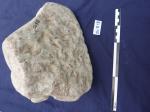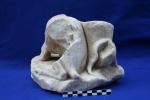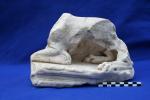
Descrizione
- 818
- miniature panther, tree stump, ovoid base with side moldings, fragment
- 4th-early 5th c. AD
- Densely grained white marble (Italian) with no streaking, polished to a 'soapy' surface.
- Base: l. 27 cm, w. 21 cm, ht. 5.7 cm. Feline: l. 27 cm, w. 10.3 cm, ht. 13 cm. Tree stump: ht. 10cm, w. 17.3 cm max, 10.5 cm diam. at the top.
- The feline’s head, front paws, upper chest, and right rear quarter are missing. Breaks, with minor exceptions, are ancient. Preserved below is the back left portion of an ovoid base with finely molded sides, about a quarter of the original base, much trimmed. The tree stump has its original height. Polish is lost but the surface is not much weathered away, under a very pale brownish-grey even encrustation.
- "Fragment of a miniaturised recumbent panther crouched alertly at a short tree stump, probably once belonging to a larger group, perhaps of Dionysus and/or a satyr/ faun in a wilderness setting. The underside of the oval base, carved in one piece with the statue, preserves the prepared surface of installation: rough-picked, then smoothed over the jagged edges. The base has ornamental moldings (scotia between two fillets).rnThe little cat, slender tail trailing, is imagined at the scale and in the posture of a house-cat, down on four bent legs, forelegs slightly splayed, nestled against a tree-stump . The further back paw emerges in low relief from the stump, a detail that would have been difficult to see behind or below the now broken-away under-belly, but which the artist has nonetheless depicted with care. The breast-bone is pronounced; and the modeling emphasises the bird-like delicacy of bone structure under the skin of the legs and extant paw. The paw is splayed, with its tiny sharp talons carefully delineated in relief on the ground.
- The figure is the smallest of the three recumbent felines found at the villa, compared to the under-life-sized S 19 and life-sized S 20. The piece comes from the winery zone, like the other two panther fragments; this one was found in a medieval context in one of the vaults. Like the other oval-base small-scale groups, it was meant to be visible (almost) completely in the round. A group at this scale would have been placed on a platform raising the worked base to at least hip level. The scale, carving style, base and molding are comparable to those of a distinctive group of miniatures, examples of which have been recovered across the Empire, and have been dated to the 4th and early 5th c.. Tiny, alert, recumbent animals at tree stumps occur as staffage in some of these, like the tiny goat in the Ganymede and Eagle group from 4th-c. Carthage (Carthage, Musée Paleo-chrétien; restored height, 49 cm). The late date is also evident from the rendering of the tree bark. It delineates the tattered condition of the fissured bark with undulant flaps like leather. The rough bark contrasts with the smooth articulation of the panther-kitten.Typical of late antique sculpture is the restriction of textured detail to a few zones: the fan of fine bones in the paw, and a whorled tuft of fur cushioning the back of the foreleg joint. This piece offers valuable evidence for the late antique history of the villa, demonstrating that sculpture for luxury display was still being purchased in the fourth or even early fifth c.
- Ganymede from Carthage and his goat, Gazda 1981a, 150-67 and 1981b; Bergmann, 1999 23 and fig. x; Stirling 2005 fig. 2 at 9, and passim. Compare also the little deer of the miniature mythological group of Diana as huntress from the Villa de Petit-Corbin à Montagne, for its recumbent posture, and its placement beside a tree right at one side of an oval base with our’s moldings (that is, a position on the base analogous to our animal); Balmelle 2001 234-5 and fig. 129; Bergmann 1999, pl. 26-8. The late antique miniatures overall, from ateliers in Aphrodisias and Rome, 4th or even 5th c.: Bergmann 1999 Stirling 1996; Balmelle, 2001 233-37; Stirling 2005 ,7-14, 65, 75, 106-9, 127, 177 and, on ‘caned’ bases and their comparanda, 65, 75, 106-7-9, 127 177. For Dionysos and panther statues, see LIMC III 1986: 414-56.















![Download [view]](/villamagna/ark//skins/villamagna/images/results/download_sml.png)




